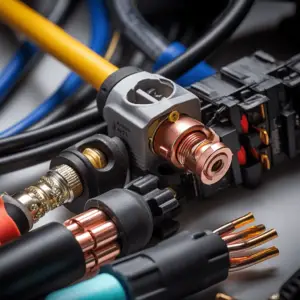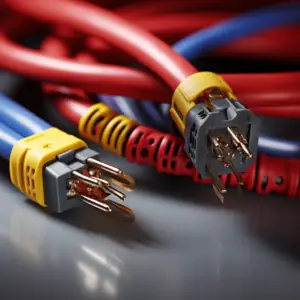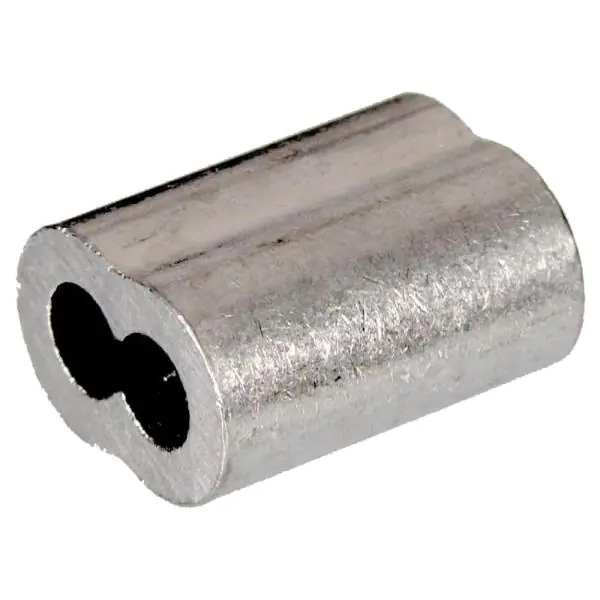Crimping Cable Ferrules Safely, Electrical work and specifically electrical connections are a pivotal part of the efficiency of a circuit regardless of size and purpose.
Poor connections or worn-out junctions and joints disrupt the flow of power and over time make the entire functionality of a circuit problematic, ineffectual, and dangerous.
A fair amount of electrical equipment is designed first and foremost with electrical safety in mind and like any good piece of equipment, it must be handy, easy to use, and durable. A ferrule is one such piece of equipment.
A ferrule can be defined as a small piece of hollow cylindrical metal usually made out of tin-plated copper. It is usually open on one or both ends.
It is used to make electrical connections neater, stronger, and safer by creating a firmer stronger hold on wires that would otherwise release each other or fray.
This is achieved by crimping a ferrule onto the ends of wires or cables and crimping the ferrule and the wires together using a crimping tool.
Ferrules are a fairly recent innovation and when crimping with a ferrule, the two wires or bunch of wires are held together inside the ferrule ‘tube’ to house them together eliminating the danger of frayed wires or loose connections occurring.
In some countries particularly in Europe, they have become industry standard and many building regulations will not certify electrical work anymore if they are not used.
Table of Contents
Crimping Cable Ferrules Safely

They are still a novelty in the United States but with safety concerns around electricity continuing to evolve, they may become the industry standard.
Crimp: To crimp is to compress or ‘squeeze’ something together in order to create a cold joint or a cold seam. In this context, it means to hold together two cables and compress the ends against each other to create a joint.
Crimping tool: This is basically any tool used to join two pieces of metal by compressing them together. There are therefore many tools that can be called crimping tools but there are those fabricated specifically for crimping called ‘crimpers’.
They tend to be quite dense and with good reason. The dense metal and heavier handles will amplify the force you apply and create a better stronger seal.
Crimpers grip the ferrule and wires within from all directions and compress the joint leaving it nearly seamless, even, and neat.
A crimper will also leave the joint devoid of any air spaces that may allow the entry of air and possible precipitation which will eventually wear out the joint. Three are two main categories of crimping tools:
Hydraulic crimpers
These have more force, therefore using any tool as a complement is unwise. This crimper is for connecting larger, broader cables that lift weights or transport high voltage.
Other crimping tools cannot generate the force needed to make a firm seam, hence they cannot be substituted.
Hand-held crimpers
These are suitable for connections that do not demand much force to make but are still dense enough that a single compress at the right gauge measurement is sufficient to create a reliable joint that can last.
How to crimp a cable ferrule without a crimping tool

Common pliers
Plier hardware is multifunctional. Cables are often pliers-crimped. Crimping has supplanted soldering (hot joints) as a dependable electrical connection method, therefore hand-held crimpers are improved pliers.
Crimping results are like soldering without the expense or effort. It was believed that soldering generated stronger bonds due to its permanency. Ferrules require more power to crimp firmly around wires, therefore conventional pliers are not crimpers. Only experienced technicians should use pliers this way. A ferrule can be crimped using regular pliers without a tool.
Hammer
A hammer and some brute force all over your ferrule may achieve what you need if the connection you are working on is simple enough.
Assuming you will end up with a working connection, you will however not create a neat one. Ensure that as much as possible you have covered the entire surface area of your ferrule to ensure the wires within are held very tight.
If you ever notice any electrical malfunction after this kind of installation, this connection should be the first place you need to evaluate. With some luck and fairly good workmanship, this connection should suffice for a long time.
Finally…
Whenever you have to improvise, ensure you grasp the concept behind the recommended tools so that even as you use a different method or piece of equipment, you do not expose your connections and consequently yourself to losses and to mortal danger.
Stranded wires, which are the kind you will find in most electrical connections tend to fray a lot. A cable ferrule would hold these wires securely preventing this.
Additionally, a crimper will exert even and forceful pressure all through eliminating room for wiggling or corrosive precipitation to penetrate the joint.
A crimper will also deform the wires sufficiently enough to almost eliminate the ‘circle within a circle problem’ which comes about inevitably. This refers to the spaces that remain when circular objects such as the thin wires within a stranded wire are housed in yet another circle, the insulation.
Simply put, the less space there is, the greater the overall efficiency of a wire so if you must improvise, ensure you can achieve maximum compression all round not just for strength but to achieve as close as possible the finessed efficiency of a joint made with a crimping tool.


